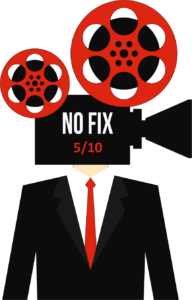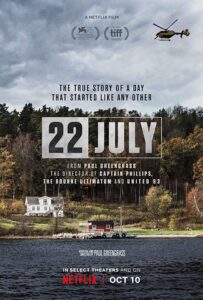
 From Paul Greengrass, writer-director of tense action pictures starring human (“United 93,” “Captain Philips”) and super-human (“The Bourne Supremacy) heroes, comes “22 July,” on Netflix, and at a theatre near you.
From Paul Greengrass, writer-director of tense action pictures starring human (“United 93,” “Captain Philips”) and super-human (“The Bourne Supremacy) heroes, comes “22 July,” on Netflix, and at a theatre near you.The first 30 minutes is pure Greengrass. An important government building explodes, a massacre on an isolated island takes place, and police, in full pursuit, find and arrest the man responsible for both events.
You’d think this rich storyline would be enough for the 2 hrs and 23 minutes that Paul Greengrass set aside for “22 July.” It is a true story. It happened, in 2011, in Oslo, Norway, and on Utoya, a short car trip and ferry ride away from the capital. 77 people were murdered, more than 200 injured.

July 22 is Norway’s September 11. An unthinkable crime of overwhelming proportions almost paralyzed a government and a country, thanks to 32-year old Anders Behring Breivik, a self-radicalized neo-Nazi, who spent five years preparing to upend democracy in one of the world’s most peaceful, prosperous countries.
Several movies and documentaries have already been made about the tragedy which might explain why Greengrass wanted to go beyond the murderous rampage. Most of “22 July” deals with the Breivik trial – the government insisted it go by the proverbial book, leading to outrage among the citizens, especially the families of the victims – and the recuperation of one very damaged survivor, Viljar Hanssen.

This changes the pace of the movie. The action-adventure turns procedural drama. Sadly, the two hours spent on the parallel stories of Hanssen and Breivik are not enough. We suffer with young Viljar, who “came back,” in that he relearned to walk, talk, and got a law degree, but bullet fragments still lodged in his brain can kill him at any moment.
What we really want to know, though, and what we are not told, is what drove Behring Breivik. Why was he such a misfit? Who was his family? Were there friends?
We see Breivik interact with his lawyer, give the Nazi salute in court, attend the impact statements from survivors. Police interview his mother. Like all mothers of murderers she insists he was “a good boy.” Yet she refuses to speak up for him in court.

There must be more to be learned about Anders Behring Breivik and there is – for his movie, Paul Greengrass bought the rights to Norwegian author Asne Seierstad’s international bestseller “One if Us: The Story of Anders Breivik, and the Massacre in Norway” and borrowed freely from it.
He just didn’t borrow enough. The book is 550 pages thick, and maybe a regular movie is the wrong forum for this harrowing project. An episodic television series would have time to develop the character of the seemingly unreachable Breivik, who never “fit in” as a child or a youth. At 27, feeling like a failure, he moved back in with his mentally unstable mother, read right-wing propaganda online, and played World of Warcraft.

At the very end of “22 July” Greengrass touches on a government report issued about the excruciatingly slow police response to the massacre taking place at Utoya.
Several hundred teens had gathered at a political youth camp on the island, and when the shooting started, they grabbed their cell phones and called the police. Distracted by the explosion at the government building downtown Oslo, the police didn’t believe the initial Utoya reports.

The children had to call their parents and ask them to call the police. When the shooting came closer, the kids began texting. Some children kept texting home for 40 minutes, until they were murdered.
This was perhaps the most harrowing aspect of the Utoya tragedy – and Paul Greengrass completely ignores it. His rah-rah approach has the cops pursuing Breivik as heroes, on land, on water, when in reality, important witness reports in Oslo were ignored, the one helicopter available couldn’t make it, and the rubber raft taking the cops to the island was overloaded and the engine choked.
Breivik actually called the police himself – twice, mid-shooting – to give himself up. He couldn’t understand why it took the cops so long.
An all-Norwegian cast performs in English, lending an almost documentary authority to
“22 July.” Of special note: Jonas Strand Gravli, who plays Hanssen, and Anders Danielsen Lie as Breivik.
If you are unfamiliar with the Utoya massacre, or need a refresher, the acting makes it well-worth your time. For a real understanding of the story, though, Asne Seierstad’s book is highly recommended.
